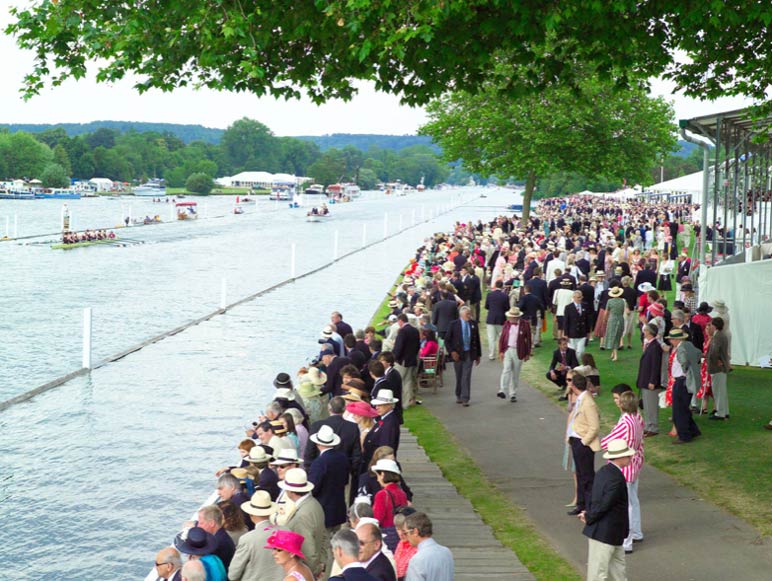Magazine Feature Articles
Henley Royal Regatta: key event of the English Summer
The spectacular round of parties and sport which is the English Season naturally includes Henley Royal Regatta—the perennial English river party, an extravaganza of giant young rowers, blue-and-white marquees, gentlemen wearing striped blazers and boaters, and ladies in their summer dresses and flowery hats.
The rowing itself perhaps does not interest more than a minority—most finding Pimms and strawberries more important—but in fact 2,000 serious oarsmen from across the world will be competing. Not only is this a showcase of English rowing but a major battlefield between the English and foreigners, particularly the Americans, who count Henley as their premier regatta. It is well worth being there to see this integral part of the English Season—a masterpiece of fun, frivolity and serious sport—particularly with an unparalleled view of the racing.
The Regatta was first held in 1839 and has been held every year since, except during the two World Wars. At this first Regatta, J D Bishop, of the Leander Club, umpired on horseback. The whole event was staged by the Mayor and people of Henley as a public attraction, including a fair and other amusements. Only later did the emphasis change so that competitive amateur rowing became its main purpose. The 1839 Regatta took place on a single afternoon and proved so popular that from 1840 onwards the racing lasted for two days. In 1986 it was extended to its present five days. The first Royal patron was Prince Albert, succeeded by Queen Victoria, after which each successive reigning Monarch has consented to become Patron. The Queen, as Princess Elizabeth, presented the trophies in 1946. The most recent member of the Royal Family to do so was the Princess Royal in 1999.
This year (2019) to commemorate the centenary of the 1919 Royal Henley Peace Regatta, Military VIIIs will once again compete against each other after a 100-year hiatus. For the first time, male and female military athletes will row in the same boat at an elite international event—crews from the original six nations of Australia, Canada, France, New Zealand, the UK and the USA, joined by Germany and the Netherlands.
It is de rigueur for a respectable gentleman to wear a lounge suit or to sport a blazer—particularly if said blazer is dazzlingly striped and worn with a boater. As one reporter wrote, ‘Henley is the excuse for men to blossom forth in some of the most outrageous club gear ever seen outside an Edwardian music hall. Gentlemen may wear blazers so gaudy as to stop an elephant in full charge, but they must also wear a tie or cravat at all times.’ Your own apparel may be less outrageous than some—in particular the fellows wearing pink socks, a pink tie and pink schoolboy cap, as they are members of Leander, the exclusive club for old Oxford and Cambridge rowing blues. Ladies should take a tip from Sir Cecil Beaton’s stage productions—dresses are best long, lavish and languorous, worn with shady hats and of course, gloves. Trousers, for ladies, are still frowned upon.
As Henley Regatta was instituted long before national or international rowing federations were established, it has its own rules. Unlike multi-lane international regattas, it operates a knock-out draw with only two boats racing in each heat. At this point the Thames is only wide enough for two, and though the Regatta authorities own 120 acres of land on both banks it is unlikely to be widened because, after all, Henley is unique and shall remain so. The good things about this are that viewing is easy, and up to 100 races are rowed on some of the five days. To complete the programme by a reasonable hour, races are started at five-minute intervals. There is no hanging about at Henley: it is all-action.
Even the length of the course is non-standard: at 1 mile 550 yards, it is longer than the normal international distance of 2,000 metres. It takes about seven minutes to cover, so that two races are being run at once on the course for much of the day. The number of races is naturally reduced each day, leaving only the Finals to be rowed on the last day.
The Regatta is one of the few major sporting occasions today to be run without reliance on commercial sponsorship or subsidy. The total cost is more than £2 million a year, most of which is derived from subscriptions paid by Members of the Stewards’ Enclosure and their purchases of additional badges for guests. Membership of the Stewards’ Enclosure is limited to about 6,000, hence the long waiting list to join—and the crowd in the Enclosure, which it is sensible to avoid if you can.
¶ For more details about visiting Henley Royal Regatta, call us on 020 7399 2960.
Image copyright Henley Royal Regatta.
PLEASE READ: CountryClubuk Club Rules and Terms and Conditions

